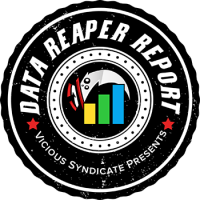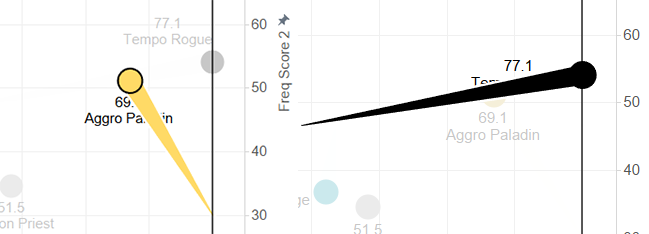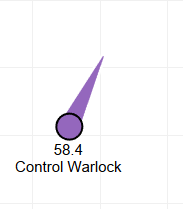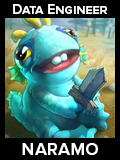
Welcome to the 74th edition of the Data Reaper Report!
Our Data Reaper Project, including the Data Reaper Live has 4,000 active contributors. Without them, this project would not be possible, so we’d like to thank all of our contributors for their help.
Quick Links
Class/Archetype Distribution | Class Frequency | Matchup Winrates | vS Power Rankings | Class Analysis & Decklists | Meta Breaker of the Week | How to Contribute | Credits
Number of Games
| Overall | 85,000 |
| Legend | 10,000 |
| Ranks 1-5 | 36,000 |
| Ranks 6-10 | 22,000 |
| Ranks 11-15 | 12,000 |
Class/Archetype Distribution
[TABS_PRO id=11688]
Class Frequency
[TABS_PRO id=11689]
Class Frequency Discussion
Priest’s numbers have risen at lower skill levels, where Dragon Priest is very prevalent, but have declined at legend, where Razakus Priest is the most popular archetype. It seems that the class has reached saturation, and while Razakus’ numbers have not taken a hit, its popularity is unlikely to rise further based on recent trends. Warlock is in a similar spot where its numbers have hit a plateau at all levels of play.
The biggest prevalence shift this week comes from the rise in Aggro Paladin. Aggro Paladin has nearly doubled its numbers at every level of play, and is now the 4th most popular archetype at legend. This was an expected rise following its fantastic performance against the field exhibited in last week’s report.
The player base has been very quick to react to Aggro Paladin’s rise, and the response has been the rise of the deck’s biggest counter, Tempo Rogue. Tempo Rogue is likely going to be a big player in the upcoming metagame, since it’s the most effective deck at taking away initiative from the opponent.
Druid has awoken from its slumber. We can observe a significant uptick in play of Jade Druid, specifically at legend ranks. This shift has yet to trickle down to lower skill levels as it’s a relatively young development. Jade Druid has also seen significant internal changes, with a shift into armor stacking builds that look to pick apart Razakus Priest’s burn plan. Aggro Druid is another archetype that’s in the process of fleshing out.
Mage has gone through a significant decline in prevalence at all levels of play, and this isn’t a surprising development considering Secret Mage’s poor matchup against Aggro Paladin. Other archetypes of the class continue to be very niche.
Hunter has continued to gravitate towards aggressive builds, and we’ve decided to re-label the Midrange Hunter cluster into Aggro Hunter. While the change is strictly about semantics, we felt that the new name describes the cluster’s current state better, since Highmanes have pretty much vanished from play. We didn’t like calling it “Face Hunter”, since it’s still very board focused and doesn’t play out like the old Face Hunter of years ago. Hunter, as a class, is going through a massive decline in play at all skill levels. Aggro Hunter is the only archetype that’s maintaining a significant ladder presence, while Secret/Spell Hunter builds are fading away.
Warrior and Shaman look like dead classes that are heading towards play rates that resemble Warlock in Un’Goro. Aggro Shaman has re-appeared over the past week in very small numbers, but there is almost nothing else to say about the internal developments of the bottom two. K&C, much like MSG a year ago, appears to have only 7 relevant classes in the metagame.
[TABS_PRO id=11690]

[TABS_PRO id=11691]
vS Meta Score
[TABS_PRO id=11692]
vS Power Rankings Discussion
Last week, we’ve introduced the vS Meta Score, and now that we’ve had two weeks’ worth of data, trends are beginning to emerge and one of the most important purposes of the new metric unfolds. If you click the vS Meta Score image and go directly to the interactive chart, you will be able to click inside the circles representing the archetypes (not the frame of the circle). Once clicked, the archetype circle will reveal a tail, similar to a Comet’s Tail, which displays their position in the plot last week. Therefore, by merely looking at the “comet”, you can now immediately understand where the deck trends towards at a specific rank, based on where it moved within the field relative to the X (win rate) and Y (prevalence) axis’. Remember, the X and Y axis are based on relative numbers, not absolute numbers, so they show the archetype’s position in the meta relative to the theoretical best deck, whose absolute values are dynamic. If you’re confused, follow the commentary we provide on the meta this week and things will become clear as you observe the chart. If you have any questions – please join our Discord channel and ask. We will be happy to answer.
The biggest story of this week is the meteoric rise of Tempo Rogue, which has elevated the archetype to having the highest win rate in the game at legend ranks in addition to its rise in popularity (Up-Right comet movement). It has closed a massive gap on Aggro Paladin over the past week. With the increased popularity of Aggro Paladin, more attention has been given by the meta in order to beat it, which results in Aggro Paladin’s drastic drop in win rate to a more reasonable score (Up-Left comet movement). In contrast, Tempo Rogue has greatly benefitted from the rise of one of its better matchups, while improving its worst matchup (Control Warlock) by a significant margin.

The biggest loser of the week is Control Warlock, which is facing major obstacles on ladder. Control Warlock is a very strong deck against aggressive decks. However, it was performing very poorly against the most popular class in the game, Priest. In order to gain percentages against Razakus Priest, it needed to add a more threatening Giants/Faceless package to its arsenal. However, adding this package sacrifices percentages against aggressive decks (Giants/Faceless are very bad cards against aggro). Therefore, Warlock is stuck between a rock and a hard place. In a ladder environment, it struggles to perform optimally against both Priest and aggressive decks with the same 30 cards, so it has to choose and adapt according to where the wind blows. Another problem it’s facing is Spellbreaker. The usage of this card, especially in aggressive decks, has jumped massively over the past week. Players have been relentless at teching against Warlock, so this is also hurting the archetype’s win rate quite substantially (Down-Left comet movement).

Some of the popular decks in the meta are hurting from Aggro Paladin’s rise due to their poor matchups against it. The most notable examples are Secret Mage, Dragon Priest and Big Priest. Pirate Warrior is another casualty, and our concerns that it would find itself lagging behind the meta have proven to be justified.
Much like in the previous meta, Razakus Priest’s dominant prevalence is not accompanied by dominant performance. This is a good sign for the meta’s health, since an archetype’s convergence into the Meta Peak is when trouble begins when it comes to game balance. The player base is very much wary of Razakus’ threat, and moves away from strategies that fall prey to it easily.
There is an interesting rise in two archetypes’ win rates. Both Aggro Druid and Zoo Warlock are looking very strong against the field at the moment despite their low prevalence. Perhaps, the reason why they are doing so well is that low prevalence. By hiding under the threats of Control Warlock and slower Druids, which are significantly more popular, they take advantage of the player base’s inclination to mulligan against the “bigger brother”. This mulligan advantage makes both Zoo Warlock and Aggro Druid overperform in matchups that may play out differently with open decklists.
Jade Druid is making steady strides back towards relevance, with an increase in its win rate at higher levels of play accompanying its increase in play rate. It is a rising threat that may prove to be an important factor in the future suppression of Razakus Priest should the latter ever look to spin out of control. As a result, Jade Druid could be a highly valuable option on both ladder and the tournament scene. It also handles Aggro Paladin well enough to not suffer from its rise. Along with Aggro Druid’s promising change, it seems that Malfurion’s firmly back in the game.
Aggro Hunter is slightly hurting from Paladin’s rise, but it’s still looking strong enough to stay in the meta. We can’t say that about Secret-based Hunter decks, which are looking weaker and weaker every day. Unless a new discovery is found, they are likely to vanish in the near future.
Things still look quite bleak for Warrior and Shaman. With Pirate Warrior’s decline, the Warrior class has little else to turn to other than some of the worst performing decks in the meta that no one but a few is bothering with. Aggro Shaman’s sample is too low to include in the power ranking table, but it would be sitting at the bottom of T3, not a promising win rate for a deck that barely sees any play. 7 classes confirmed?
Class Analysis & Decklists
Druid | Hunter | Mage | Paladin | Priest | Rogue | Shaman | Warlock | Warrior
Priest continues to shine with three archetypes looking highly competitive. While the rise of Aggro Paladin is slightly troublesome for Big and Dragon Priest, they are still looking strong. Razakus Priest is the late game meta defining deck that holds the highest weight in determining whether an archetype sinks or swims in the current meta.
Most Dragon Priests on ladder run the Spiteful Summoner package. Builds vary between running 2-drops or Keleseth/Patches. The 2-drops of choice are Netherspite Historian, Shadow Ascendant and Faerie Dragon. Some lists runs 4 or 5 of these early drops, with an additional tech choice, such as Spellbreaker/Songstealer or Twilight Acolyte, included. The Keleseth variant drops this package to add pirates, making its early game less consistent but more explosive.
Big Priest remains a strong and consistent option for ladder. The inclusion of Diamond Spellstone helps the archetype win the long and grindy games, since its threat generation becomes much more powerful with it.
Razakus Priest is mostly settling into the heavy cycle style we’re already familiar with, and the standard builds did not change much from the previous expansion, mostly including just one new card, Psychic Scream. Hunterace, arguably the best Razakus Priest player on ladder, hit #1 legend with his trademark Lyra variant that includes Mass Dispel, which can do a lot of work against Paladins and Warlocks. Gadgetzan Auctioneer can slot in to replace Lyra, without needing to change other cards.
The second week of the expansion has given the meta time to breathe and stabilize a little bit, and one thing is certain, Warlock has a pretty significant Priest problem. Big Priest in particular is a nightmare for all Warlock varieties and Raza Priest’s prevalence forces Control Warlock into a specific build path.
Control Warlock is the most popular Warlock archetype by a large margin, but while initial innovation was strong, we haven’t seen major changes in the deck’s construction since our last report. The most important trend is the prevalence of Giant/Faceless lists on ladder, which was started up by the efforts of Abar, Zalae and Posesi. The main selling point of Giants-based builds is a much better matchup against Razakus Priest. Rather than being highly unfavored, the pressure of the additional threats makes this a much closer matchup that can go either way. But, by running these additional threats, you’re sacrificing significant percentages against aggressive decks. This means that Control Warlock’s overall win rate against the field is unlikely to be dominant. In the build we are featuring, consider Spiritsinger Umbra and Prince Taldaram to be the flex spots. Spellbreaker is a popular tech card that can replace either one (preferably, Umbra), and some players include N’Zoth instead as a secondary Voidlord generator.
Zoo Warlock is continuing to display surprisingly good win rates, and it may have to do with its mulligan advantage on ladder since most players are expecting a slower opponent when they run into a Warlock. Amnesiac’s and Xixo’s lists remain the gold standard, though Amnesiac’s buff-heavy list may be more vulnerable to the increasing frequency of Spellbreaker. Zoo maintains its excellent performance against minion-light archetypes, and is particularly strong against Druid and Mage. Nevertheless, there are significant shortcomings to the archetype. Other minion heavy tempo decks are generally a turn faster than Zoo, and while the matchups against Control Warlock and Razakus Priest are not terrible, Zoo doesn’t hold an advantage against either.
Tempo Rogue has remained the deck of choice for most Rogue players. While the standard list for Tempo Rogue remains the same, Spellbreaker has proven to be an important tech card in order to overcome the archetype’s worst matchup in Control Warlock, by either silencing Possessed Lackey or pushing through an already established Voidlord. The card often sacrificed in order to include the tech is Saronite Chain Gang, though some cut Scalebane instead.
The 2nd most popular Rogue deck is Kingsbane Rogue, largely due to its meme potential, as its win rate is atrocious and it’s more popular at lower skill levels as well as at rank floors. The mill variant can be a whole lot of fun, but successfully climbing ladder with it is not going to be easy. GrayJ did find use for Kingsbane on his climb to top 100 legend, but by including the legendary weapon in a very different shell/archetype – an aggressive list that focuses on pirates.
Miracle Rogue is mostly utilized by those with a passion for the archetype. Sap is one of the cards that encourages Rogue players to make the switch to Miracle as it’s one of the best answers in the game to a Voidlord. A Miracle Rogue enthusiast of note is Casie, who opted for an even faster list than Mr Yagut’s, with Shadowstep providing extra burst potential with Leeroy, as well as additional utility. Casie played this list extensively at top legend ranks, with a fairly successful winrate. Arcane Giants have fallen out of favor in the current meta. However, Sebastian Jo reached #13 legend with a giants variant of the archetype, showing it might yet be a viable alternative.
Quest Rogue has continued its attempts at revival, and does have potential to punish a narrow Priest meta. Ryvius reached #5 legend with a list that also includes Wax Elemental, a card that helps slow down aggressive decks while also being very strong post-quest completion.
Mage’s most dominant archetype remains Secret Mage, and the deck is shaping up to be very strong in slower enviornments where it’s able to hold an advantage against Priests as well as Warlocks trying to beat Priests. It struggles against other aggressive classes that deny it space, with the most prevalent ones being Rogue and Paladin.
One important development in Secret Mage has been the addition of the pirate package. While Southsea Captains have been experimented before, Wabeka pioneered running Southsea Deckhands instead. The Deckhands offer a reasonable turn 1 play in a deck that otherwise heavily relies on drawing Mana Wyrm to establish initative, and once Aluneth is equipped, they turn into an efficent source of damage. Pirates also fuel your Corridor Creepers. In order to add the pirate package, we cut Sorcerer’s Apprentices, the worse performing minions in the deck, as well as Firelands Portals, which are very slow and hard to dump once Aluneth is equipped. Pyroblast remains the 30th card, as it can be the difference maker in the matchup against Control Warlock.
Exodia Mage continues to prey on slow archetypes, but rolls over when facing faster decks. Fenom was able to hit top 100 legend with a build that runs Ghastly Conjurers instead of Babbling Books. The Conjurers offer a more reliable and cheap generated spell that helps you delay the game and protect your life total.
Other Mage archetypes aren’t doing too well since they are less reliable anti-aggro decks than Control Warlock, and their late game plan pales in comparison to Razakus Priest.
Paladin is doing incredibly well. Aggro and Murloc lists are crushing the field right now, with Aggro Paladin beginning to gain significant traction, but as it gets popular, its performance level is dropping.
Aggro Paladin’s standard lists remain the same. We recommend that if you’re encountering a significant number of Warlocks, consider running a Spellbreaker (some are even running two) instead of an Acherus Veteran. The matchup against Warlock is not nearly as bad as it’s perceived, and with the additional tech, becomes very winnable. The most difficult ladder opponent for Aggro Paladin is actually Tempo Rogue.
Murloc Paladin is also doing incredibly well, but is suffering from a redundancy issue, since Aggro Paladin appears, for now, to be a superior choice in the current meta. This is particularly true because Murloc Paladin has a much more difficult time dealing with Control Warlock. Since its board development is synergy based, it’s much more reliant on having minions survive a turn, which makes AOE more punishing. Murloc Paladin could become a stronger option should Jade Druid rise, as the vertical pressure that results from its tribal synergy is not as weak to Druid’s key defensive tools of Spreading Plague and Swipe. This week, we’re featuring BoarControl’s Murloc Paladin list which runs Southsea Captains and Patches. We’ve heard Patches was a strong card, and since this is an aggressive Hearthstone deck, playing the best early game card makes some sense. The other approach is to focus more on buffs with Coldlight Seer, as exhibited in Feno’s list.
There isn’t much else to talk about in “off-meta news”. Rage has been experimenting with a Control Paladin build that runs the Exodia horsemen package through Auctionmaster Beardo and Burgly Bullies. Though this deck can be a fun change of pace, the execution of its win condition relies on your opponent giving you two coins, which can be difficult to rely on.
Hunter play rates have already started declining considerably compared to last week. As other top decks became more refined, Hunter builds have begun to stagnate. Spell Hunter, in particular, took a huge hit to its representation this week, with players realizing that the power plays of the deck are not worth its inconsistency. Aggressive Hunter builds haven’t received much development this week, with most top legend players and streamers switching to other classes. The one Hunter archetype that received any noteworthy development this week is Secret Hunter, with which Orange toyed around. His build turns away from most beast synergy in favor of a stronger midgame. Both Bearsharks and Spellbreakers allow the deck to push face damage more aggressively after defending the board with secrets early on. The secret package can be fine-tuned based on how the meta shapes out, with extra Wandering Monsters, Snake Traps, or an Explosive Trap all being valid tech options.
Druid certainly has the potential to claw its way back up into a more favorable position.
Jade Druid shows more promise this week with its good matchup against Razakus Priest. This is in part thanks to builds that maximize armor gain in order to fatigue the Priest. An example is the Armor Jade Druid by Hungry4Kill who took it to #1 legend. With Feral Rage, Branching Paths and Earthen Scales, this list can consistently reach absurd armor totals that no Priest can effectively burn down. Jasper Spellstone is a good fit for the deck since it is very easy to upgrade, and Branching Paths shines as a flexible tool that can help the Druid in any situation. MrYagut hit #1 legend by gearing the armor build towards beating Control Warlocks with two copies of Spellbreaker and an Acidic Swamp Ooze at the cost of reducing the armor package, and as a result sacrificing some percentages against Razakus. If you’re seeing less Warlocks/Priests, and more aggressive decks, the Oaken Summons Jade list is a better choice.
Aggro Druid is benefitting from good matchups against many of the aggressive decks in the meta, including Aggro Paladin, which is elevating its performance against the field. The overwhelming amount of AOE at the disposal of Warlocks and Priests is still hard to deal with for the archetype. Big Druid has a difficult time balancing out its build to beat two extreme ends of the meta spectrum.
Things are looking quite poor for Warrior. It’s not the least played class, but it is so far behind the rest of the pack that for all intents and purposes, it is. Pirate Warrior appears to be the only way to go, with Spiteful Summoner/Prince Keleseth lists leading the way. The archetype’s win rate is beginning to suffer, and it’s facing the same problem as it did during the KFT meta where it was just weaker and less interesting than other aggressive decks that have better tools to control the early game.
None of the other Warrior archetypes seem to have taken off at all so far. Various control-based options are available, such as N’Zoth Warrior, Big Warrior and Taunt Warrior, but all display such poor win rates that it’s very unlikely that any of them could take off. It looks like Warrior fans will have to wait until the next expansion for any chance at the revival of the class.
This holiday season could have been much happier for Shamans if they weren’t this terrible. The class continues to be hounded by the same problems that have been following it for the past couple of weeks: poor performance and very little innovation which leads to abysmal usage rates.
Token Shaman saw some success this week with Zorkthar having a good win rate with his build at legend ranks. The list cuts the slow Primalfin Totem for Dire Mole, which helps the Shaman contest the board better against Aggro Paladins. It also runs two Unstable Evolutions, which are good cards in the late game and provide some fuel for the Shaman’s assault against slower decks.
CitizenNappa managed to reach #5 legend with an Aggro Shaman list that is reminiscent of the Tunnel Trogg/Totem Golem glory days. The list is filled with burn spells, which helps the Shaman finish games past massive taunt walls, a common trait of Warlock these days. While this achievement gives some hope for the class, Aggro Shaman does not have the powerful early game it used to be famous for. Tunnel Trogg and Totem Golem were the backbone of the deck, providing a frightening snowballing threat. Dire Mole is great and all, but it’s no Tunnel Trogg.
The meta pendulum is beginning to swing. The expected rise in Aggro Paladin has occurred, with the player base understanding the threat and responding accordingly with the best answer available, Tempo Rogue. With Rogue’s primary counter, Control Warlock, feeling the hatred of 10,000 Spellbreakers, the field is very inviting for Valeera to dominate. The expected rise in Tempo Rogue and its effective suppression of early game decks should slow down the meta. What will be interesting to see is whether Jade Druid is capable of flexing its muscles and defying Razakus Priest’s late game domination with its larger and larger men, as well as its larger and larger armor. The K&C meta looks to be developing a very intricate relationship between archetypes, and understanding these relationships, will help you become a better player.
Our Data Reaper Project, including the Data Reaper Live has 4,000 active contributors. Without them, this project would not be possible, so we’d like to thank all of our contributors for their help.
Preparing our weekly article requires a significant amount of time and effort from many individuals. We would like to wholeheartedly thank our current Patreons, whose generous donations help us fund computing and server costs.
vS Gold is a new membership plan aimed to support our efforts towards improving our content and data analysis while receiving some bonuses and extra features.
Tier 3+ Patrons
Special thanks to Leo G, Chungfr, Kognar, Aaron B, Jed M, Drew M, Alan J, lalasong, Eric L, Steve F, Batz, Jeffee83, Zolstar, Pink Mage Diaries, Dekkster Gaming, Connor L, Eric H, Lim E, Stefan D, Audun K, and Sean H for supporting us for the month of December.
A HUGE thank you to our Tier 5 Patron(s): ByteCookie, and Curt S!
Contributors
Here are all the people that participated in bringing you this edition of the vS Data Reaper Report:































I disagree in one point, the Spell Hunter is not inconsistent, it is just not aggressive or combo enough for this meta, although the list you published is really trash (AND inconsistency, that one is inconsistency). The problem with spell hunter is that if your opponent wants to play combo decks and can heal (warlock and priest…), Spell Hunter is in a huge disadvantage, but if your opponent wants to out Tempo you, he will not going to make, unless you play with the trashy list you showed us here. Take Kibler’s list or Noxious’ they are much better.
kibler an noxious and casual streamers not high legend players. i believe these guys more to be honest.
As always, thank you for doing what you do!
I’m hardstuck R1, never been Legend… hoping for a Christmas Miracle!!
Aggro pala got me there for the first time yesterday after being stuck a R3-5 for ages. You got this.